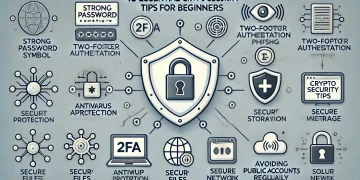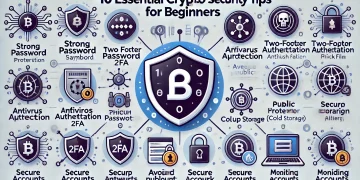Crypto Mining for Beginners: A Comprehensive Step-by-Step Guide
Table of Contents
- Introduction to Cryptocurrency Mining
- Understanding the Basics
- Getting Started: Essential Requirements
- Step-by-Step Guide to Setting Up Your Mining Operation
- Optimizing Your Mining Operation
- Understanding Mining Economics
- Legal and Tax Considerations
- Environmental Impact and Sustainable Mining
- Common Challenges and Troubleshooting
- Future of Crypto Mining
- Conclusion
Introduction to Cryptocurrency Mining
Cryptocurrency mining has evolved from a niche hobby to a global industry worth billions of dollars. As the backbone of many blockchain networks, mining plays a crucial role in validating transactions and securing decentralized networks. This comprehensive guide aims to demystify the process of cryptocurrency mining, providing beginners with a clear roadmap to start their mining journey.
Whether you’re drawn to mining out of curiosity, as an investment strategy, or to support your favorite blockchain projects, this guide will equip you with the knowledge and steps needed to begin. We’ll cover everything from the basic concepts and required equipment to step-by-step setup instructions and optimization techniques.
It’s important to note that while mining can be profitable, it also comes with risks and challenges. This guide will help you make informed decisions and understand the complexities involved in cryptocurrency mining.
Understanding the Basics
Before diving into the practical aspects of setting up a mining operation, it’s crucial to understand the fundamental concepts behind cryptocurrency mining.
What is Cryptocurrency Mining?
Cryptocurrency mining is the process by which new coins are created and transactions are verified and added to a blockchain. Miners use specialized hardware to solve complex mathematical problems, and in return for their computational work, they are rewarded with newly minted coins and transaction fees.
How Does Mining Work?
At its core, mining involves the following steps:
- Transaction Verification: Miners collect and verify pending transactions on the network.
- Block Creation: Verified transactions are bundled into a block.
- Proof of Work: Miners compete to solve a complex mathematical puzzle (the “proof of work”).
- Block Addition: The first miner to solve the puzzle gets to add the new block to the blockchain.
- Reward Distribution: The successful miner receives a reward in the form of newly minted coins and transaction fees.
This process ensures the security and integrity of the blockchain while also distributing new coins in a decentralized manner.
Types of Mining
There are several approaches to cryptocurrency mining:
- Solo Mining: Individual miners attempt to mine blocks on their own. This method is increasingly difficult and rarely profitable for most cryptocurrencies.
- Pool Mining: Miners combine their computational power in a “pool” to increase their chances of mining blocks. Rewards are shared based on the contributed computing power.
- Cloud Mining: Users rent mining hardware hosted and operated by a third party. This eliminates the need for personal hardware investment but comes with its own risks and lower profit margins.
- CPU Mining: Using a computer’s central processing unit to mine. This is now obsolete for most cryptocurrencies due to its inefficiency.
- GPU Mining: Utilizing graphics processing units, which are more efficient for mining certain algorithms.
- ASIC Mining: Using Application-Specific Integrated Circuits designed specifically for mining particular cryptocurrencies. These are typically the most efficient but also the most expensive.
For beginners, pool mining with GPUs or ASICs is often the most accessible and potentially profitable option.
Getting Started: Essential Requirements
Before you can start mining, you’ll need to gather the necessary equipment and resources. Here’s what you’ll need:
Hardware
The type of hardware you’ll need depends on the cryptocurrency you intend to mine:
- For Bitcoin and SHA-256 based coins:
- ASIC miners like Antminer S19 Pro, Whatsminer M30S++, or Avalonminer 1246
- Price range: $2,000 – $10,000+
- For Ethereum and other GPU-mineable coins:
- High-end graphics cards like NVIDIA RTX 3080, AMD Radeon RX 6800 XT
- A capable power supply unit (PSU)
- Motherboard, CPU, and RAM to support multiple GPUs
- Price range: $1,000 – $5,000+ per rig
- For both:
- Reliable internet connection
- Surge protectors
- Proper cooling systems (fans, air conditioning)
Software
You’ll need several types of software:
- Mining Software: Specific to your chosen cryptocurrency and hardware. Examples include:
- CGMiner or BFGMiner for Bitcoin ASIC mining
- Ethminer or Phoenix Miner for Ethereum GPU mining
- Wallet Software: To store your mined cryptocurrencies securely.
- Operating System: Windows or Linux, depending on your preference and the mining software requirements.
Electricity and Cooling
- Electricity: Access to cheap, reliable electricity is crucial. Mining consumes a lot of power, so electricity costs will significantly impact profitability.
- Cooling: Proper ventilation and cooling systems are essential to prevent hardware damage and maintain efficiency.
Step-by-Step Guide to Setting Up Your Mining Operation
Now that you understand the basics and have an overview of the requirements, let’s walk through the process of setting up your mining operation.
Step 1: Choose Your Cryptocurrency
The first decision you need to make is which cryptocurrency to mine. This choice will determine your hardware needs and potential profitability. Consider factors such as:
- Mining difficulty
- Coin value and market stability
- Hardware requirements and availability
- Your budget and electricity costs
For beginners, popular options include Bitcoin (requires ASIC miners) and Ethereum (can be mined with GPUs). However, it’s worth researching other cryptocurrencies that might be more profitable or align better with your resources and goals.
Step 2: Select Your Mining Hardware
Based on your chosen cryptocurrency, acquire the appropriate mining hardware:
For Bitcoin and other ASIC-mineable coins:
- Research current ASIC models, comparing hash rates, energy efficiency, and prices.
- Purchase from reputable manufacturers or trusted resellers.
- Consider factors like noise levels and heat generation, especially if mining at home.
For GPU-mineable coins like Ethereum:
- Choose high-performance GPUs known for mining efficiency.
- Ensure your other components (PSU, motherboard, etc.) can support your chosen GPUs.
- Consider building multiple rigs to increase your mining capacity.
Step 3: Set Up a Crypto Wallet
You’ll need a wallet to receive and store your mined cryptocurrencies:
- Choose between software wallets (desktop or mobile apps), hardware wallets (physical devices), or paper wallets.
- For beginners, a reputable software wallet is often the easiest to start with.
- Ensure you follow best practices for wallet security, including backing up your private keys or seed phrases.
Step 4: Join a Mining Pool
For most beginners, joining a mining pool is recommended:
- Research mining pools for your chosen cryptocurrency, considering factors like pool size, fees, and payout methods.
- Create an account on your chosen pool’s website.
- Note down the pool’s server address and port number, which you’ll need when configuring your mining software.
Step 5: Install and Configure Mining Software
The exact process will vary depending on your chosen cryptocurrency and hardware, but generally:
- Download mining software compatible with your hardware and cryptocurrency.
- Install the software on your mining rig.
- Configure the software with your mining pool information and wallet address.
- Adjust settings for optimal performance, balancing hash rate with energy consumption.
Step 6: Start Mining
With everything set up:
- Start your mining software.
- Monitor your mining stats through your software interface and mining pool dashboard.
- Keep an eye on your hardware temperatures and performance.
- Be patient – it may take some time before you see your first rewards.
Optimizing Your Mining Operation
Once your mining operation is up and running, consider these optimization strategies:
- Overclocking: Carefully increase your hardware’s performance, but be aware of the risks of damage or instability.
- Power Tuning: Find the optimal balance between power consumption and hash rate.
- Cooling Optimization: Ensure proper airflow and consider additional cooling solutions to maintain optimal operating temperatures.
- Regular Maintenance: Keep your hardware clean and update your software regularly.
- Monitoring and Analytics: Use monitoring tools to track performance and quickly address any issues.
Understanding Mining Economics
Successful mining requires a good understanding of the economics involved:
- Profitability Calculations: Use online mining calculators to estimate potential profits based on your hardware, electricity costs, and current market conditions.
- Break-Even Analysis: Determine how long it will take to recoup your initial investment.
- Market Monitoring: Keep an eye on cryptocurrency prices and mining difficulty, as these significantly impact profitability.
- Reinvestment Strategy: Decide whether to hold your mined coins, sell immediately, or reinvest in more mining equipment.
Legal and Tax Considerations
Cryptocurrency mining has legal and tax implications that vary by jurisdiction:
- Legality: Ensure crypto mining is legal in your area. Some countries have banned or restricted mining activities.
- Taxes: In many jurisdictions, mined cryptocurrencies are subject to income tax. Keep detailed records of your mining activities and consult with a tax professional.
- Energy Regulations: Be aware of any local regulations regarding high energy consumption, especially if mining from home.
- Business Registration: Depending on the scale of your operation, you may need to register as a business entity.
Environmental Impact and Sustainable Mining
The environmental impact of cryptocurrency mining is a growing concern:
- Energy Consumption: Understand the energy requirements of your operation and its environmental footprint.
- Renewable Energy: Consider using renewable energy sources to power your mining rigs.
- Efficiency Improvements: Stay updated on more energy-efficient mining hardware and algorithms.
- Carbon Offsetting: Some miners choose to invest in carbon offset programs to mitigate their environmental impact.
Common Challenges and Troubleshooting
As you embark on your mining journey, you may encounter various challenges:
- Hardware Failures: Learn basic troubleshooting for your mining equipment.
- Software Issues: Keep your mining software and drivers updated to avoid compatibility issues.
- Network Problems: Ensure a stable internet connection to maintain consistent mining.
- Profitability Fluctuations: Be prepared for changes in profitability due to market volatility and increasing mining difficulty.
- Heat Management: Develop strategies to manage the heat generated by your mining equipment, especially in warmer climates.
Future of Crypto Mining
The landscape of cryptocurrency mining is continually evolving:
- Proof of Stake: Many cryptocurrencies are moving towards Proof of Stake, which doesn’t require traditional mining.
- New Mining Algorithms: Stay informed about new mining algorithms that may offer better efficiency or ASIC resistance.
- Regulatory Changes: Be prepared for potential changes in regulations that could affect mining operations.
- Technological Advancements: Keep an eye on developments in mining hardware and renewable energy technologies.
Conclusion
Cryptocurrency mining can be an exciting and potentially rewarding venture, but it requires careful planning, investment, and ongoing management. This guide has provided you with a comprehensive overview of what’s involved in starting your mining operation, from understanding the basic concepts to setting up your equipment and optimizing your processes.
Remember that the cryptocurrency landscape is highly dynamic, with frequent changes in technology, market conditions, and regulations. Successful miners stay informed, adapt to changes, and continuously optimize their operations.
As you begin your mining journey, start small, learn from experience, and gradually scale your operation as you become more comfortable with the process. Always prioritize security, both in terms of your equipment and your mined assets.
Whether you’re mining for profit, to support blockchain networks, or simply to learn about this fascinating technology, approaching it with knowledge and careful planning will set you up for the best possible experience. Happy mining!






























